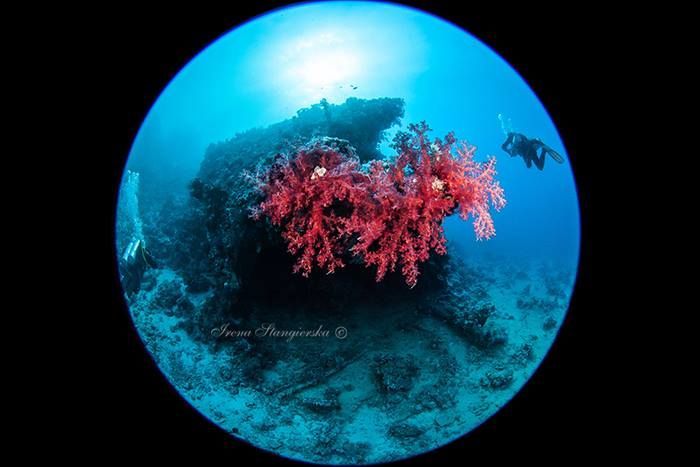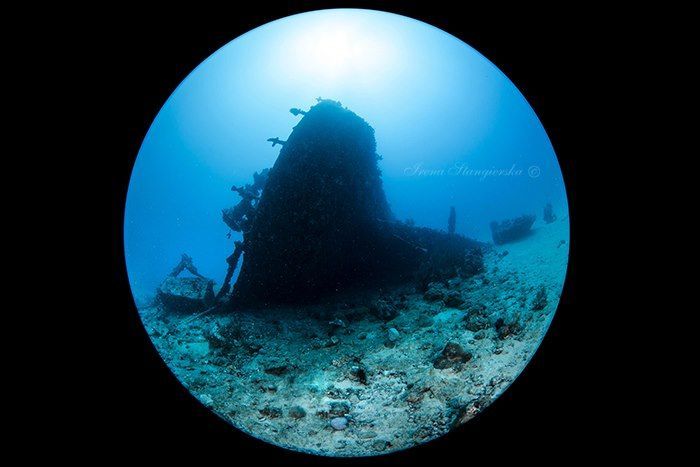Planning decompression dives – chosen practical aspects.
Planning decompression dives
Planning decompression dives – chosen practical aspects.
Gas is one of the three basic states of matter, in which the particles interact weakly. Gas particles move freely, within the whole volume and constantly collide with each other. Gases do not have a given shape and volume. They fill the whole available space and mix homogeneously. They also have the ability to be compressed and to diffuse.
Even though history of recreational diving starts in the 1940s, first case of decompression sickness (DCI) had been described hundred years before. In the 1840s people working under pressure were showing signs and symptoms of DCI, after coming out of the pressurized (caisson) chambers. The doctors couldn’t explain the cause of the sickness, but they had described the signs and symptoms of it as early as in 1854. Haldane’s (together with other scientists) researches, had lead to a publication of an article : “Prevention of Compressed Air Illness” (Journal of Hygene, 1908). This text was a turning point in the research on decompression sickness. However, this disease is still being investigated. Decompression is based on mathematical algorithms, that determine the amount of gases, that had been dissolved in a body under higher pressure (during the dive). These calculations allow a slow expansion of gases during ascent.
Gas diffusion, saturation, supersaturation, decompression algorithms, Dalton’s law (and other gas laws), neohaldane models, vesicle models, tissues, microvesicles, M values, halftimes …… Is it necessary to understand these and many other terms to dive safe? They are being taught during deep diving courses. We will also find them in books and articles. What do we really need to learn and understand? And what does the author of the fragment below trying to tell us?
“ Having a known exponential equation that is the solution of the differential equation dP/dt = k(Pi – P) (later named : the tissue saturation/desaturation equation) where P is the changing pressure of the gas dissolved in a tissue in [mH2O] and t is the time during which the changes occur in [min] “ … etc…
Does it ensure a safe dive? Or maybe we should learn how exactly our equipment is build and how to service it professionally? What about the boat? The weather? Decompression seams to be the pain in the neck for a sport diver. Breathe calmly, keep your airway open during ascent, check how much gas you have left, etc. These simple rules used to be all it was there for the first divers. Nowadays diving is a sport with a countless amount of rules, guidelines and tips. They are based on scientific knowledge, experience and common sense. Changes here happen constantly, together with the development of new equipment and diving techniques. Also new experiences and scientific researches bring new guidelines for diving. There is a continuing process of development in the field of avoiding DCI. There is a lot of new studies, works, knowledge – because of these the dives are safer. The proper understanding of the processes that happen in our bodies is crucial for safe decompression dives. Getting rid of the excess gas and feeling well after a dives might actually be easier than you think. There is no need for mastering all the knowledge, but being aware of the complicated physiological, physical and chemical processes, as well as threats and how to deal with them is the key to your safety. Organizations and instructors that have been running these programs for years know how to find the right balance. How to put together: the joy of safe diving, the necessary theory, the right knowledge and the diving practice. One of the technical divers I have met on my way offered me to do some dives to 100 m. He was really surprised when I told him about three different deco gases. “Due to my calculations EAN50 is enough” he said. Well… Is it possible ? Of course it is possible to plan a dive like that. Would it be a reasonable plan? No! Present knowledge and possibilities allow us to plan such a dive so much safer. Does it mean we have a warranty that everything will work out? The only 100% certain way to avoid decompression sickness is to not dive. But we can and we should minimalize the possible risk and potential problems.
Choosing gases for the dive we should think about this points :
– travel gas (usually on of the deco gases)
– fair amount of the bottom gas
– deco gases
– the amount of gases should be base on the usage, type of dive, the group.
Choosing the bottom gas is based on MOD, TOD and END.
When it comes to the choice of the decompression (deco) gases there are different views. Guided by my knowledge and practice I would base my choice on this elements:
– maximal optimization of deco
– minimalizing the counter diffusion during the gas switch
– establishing a bail-out.
Optimizing the decompression – mainly by stating the 02 levels on the maximum allowed values (even up to 1,6 ppo2).
Isobaric counter diffusion problem – It is a vast subject for another article. We have to remember that in some cases due to the trimix to nitrox switch the added amount of gas in the tissues raises. It happens because the raise in the amount of gas in the tissues (due to the nitrogen percentage increase i.e. from 55% to 68% so by 13%) is not compensated by an even decrease in an amount of gas in the given tissue (the helium percentage goes from 25% to 0%). Hence we can observe DCI symptoms in fast tissues.
Bailout option : each chosen gas should be available from a previous depth in case on a catastrophic gas loss.
For example: While diving to a depth of a 100 m, a good first gas would be the one that gets us to a depth that is reached due to an emergency situation (i.e. 70-75 m). This mixture apart from a proper amount of helium (END, ICD) should have a maximum allowed percentage of oxygen (based on the ppO2 rules). The goal here is to wash out the inert gases. Regarding this rule the next deco gas should be available from a previous depth (in case on a gas loss we could reach it) i.e. 40m. Then we use the next gas from 10 m. In this example we not only optimize the process of getting rid of inert gases, but also have a chance in case of a gas loss. We also have a fair amount of extra gas – that is an additional advantage. Planning the dive this way we fit the mixtures to dive plan and to not try to fit ourselves to the gases -as it happens usually when we use EAN50 and 100% Oxygen. Of course this procedure might get complicated with some dives. The main goal in choosing the right gasses is to get out of the water safely without any symptoms and in shortest possible time.
Other crucial elements of dive planning:
1. Chose trustworthy and commercially available programs
2. Register and used licensed software
3. Do read the manuals
4. Get the most you can, from the classes and learning process
5. Talk to the technical support team.
6. Use your real personal parameters.
7. Chose conservative programs or more rigorous versions
8. Do follow the changes and updates – be open but analyze!
Remember that a dive plan has to include (at least):
– Real dive plan
– Longer & deeper dive plan
– Bail-out plan
Have a dive plan for the maximum depth and time of the dive and also for a longer and deeper dive. Do take diving tables with you (i.e. your own notes with a runtime on it). Remember that in an emergency situation you have no time to remind yourself and use some other solutions or to do extra calculations(i.e. RatioDeco). When planning a dive think about:
– Your training, certificate and experience
– Equipment
– Compliance with your own self and the group. The dive parameters should be based on the diver that has the lowest training level, the smallest experience and weakest equipment.
– Physical and mental readiness for the dive
– Volume and working pressure of the tanks
– Gas consumption per minute
– Gas management rules
– Maximal bottom time and critical pressure (CP)
– %CNS calculation- Ascent rate and safety stops
– Acting plans : before, during and after the dive.
Plan your deco ! Don’t improvise! All the remarks, manuals, guidelines might be useful only for a person who interprets them in a responsible way. Nowadays, with the level of the equipment, experience and technique, the weakest link here is the diver. When using good diving practice, based on proper, well-applied knowledge the decompression seams to be safe and conquered. Or at least this is what I wish for You and myself.
Romuald Michał Hłobaż
MDT ‘The art of diving’ Wroclaw
Romek Hłobaż – professional and technical diver, PADI/DSAT instructor, issued more than 1,500 certificates. Rewarded for achieving teaching / educational state honors – Medal of the National Education Commission. „He made his career in 5000 dives in waters around the world, participated as a consultant and diver safety record depth of Polish and other interesting projects dive. Aware of the risks and awe is not drowned out routine depth of 100 m exceed a few dozen times and his knowledge, calmness and composure, many allowed the safe return of this depth. Author picture film special – www.filmpolski.pl author of the book „Dotknąć Głębi” www.dotknacglebi.pl. works at the Center diving MDT www.mdt.wroclaw.pl







